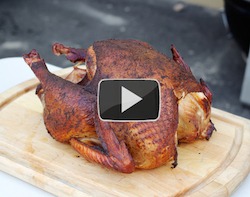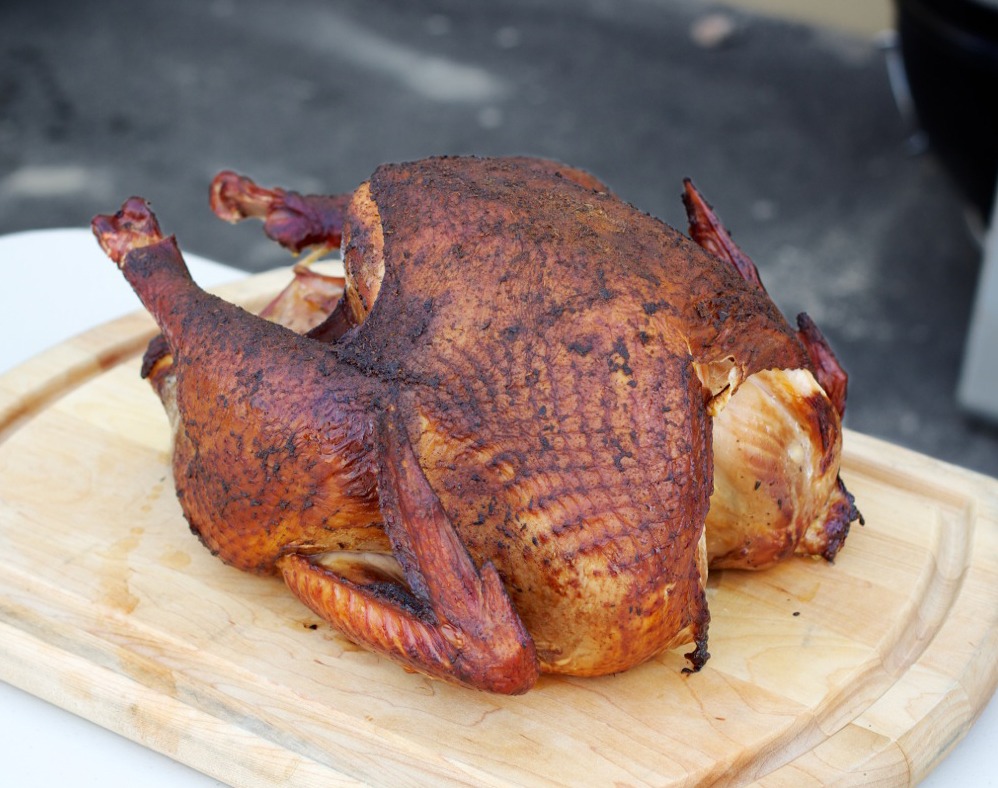 Here at the ThermoWorks we’ve been hard at work pouring over recipes looking for the perfect alternative to the traditional Thanksgiving turkey roast. We’ve consulted with top chefs and leading BBQ gurus, and have cooked up the better part of a “gang” of turkeys. Finally, we’ve come up with – what we believe – is a great way to shake things up this 4th Thursday in November.
Here at the ThermoWorks we’ve been hard at work pouring over recipes looking for the perfect alternative to the traditional Thanksgiving turkey roast. We’ve consulted with top chefs and leading BBQ gurus, and have cooked up the better part of a “gang” of turkeys. Finally, we’ve come up with – what we believe – is a great way to shake things up this 4th Thursday in November.
Smoking a turkey, as opposed to roasting, will not only free up your indoor oven for more important things (e.g. pie), but will also add a unique flavor that your guests may have never had before. And because smoking meats hearkens back to our pilgrim forbearers, it’s only right that this Thanksgiving you introduce your guests to the rich and flavorful tradition of smoked meats.
Step One: Prepare the Pit
Smoking a turkey requires an outdoor cooker. To be honest, a gas grill or traditional grill will work too, it’ll just require a little creativity to help you achieve the indirect cooking method you’re looking for. But, that’s another article. Suffice it to say, you don’t want to try and smoke a turkey in the house. Consider yourself warned!
To achieve an even cook throughout the bird you’re going to want to steady the heat in your pit between 235-275°F. This is going to require just the right amount of coals (or wood), a quick lesson in ventilation and a few heavy duty thermocouple temperature probes to give you accurate temperature readings. (We found that cooking lower and slower helps the meat retain much of its moisture and more often than not, leads to a delicious flavorful bird. Where possible, aim low!)
Lay down a layer of unlit coals at the bottom of your cooker (For a four-hour cook we used an estimated 10lb of charcoal.). In an effort to achieve an even burn throughout, add several hot embers to the top of the unlit coals and let them go to work until they’ve brought your smoker up to temperature.
Adjust the vents on the bottom and top of the smoker until you’ve achieved your ideal cooking temperature. Opening the vents will allow for more airflow and will increase the heat. Closing the vents will shut off the airflow and decrease the heat. Play with the vents until you find the perfect balance and achieve a steady temperature.
Most cookers come with factory installed dial thermometers mounted to the hood of the pit. Whatever you do, don’t count on them to give you an accurate indication of what’s going on inside your cooker. Not only can they be several degrees off, but positioned in the dome of the cooker, they’re not telling you what’s happening near the turkey on the grates.
Know what’s going on inside your cooker with professional-grade thermocouple sensors that clip directly onto the grill grates. They’ll give you accurate and real-time temperature readings. When you know the actual temperature you’ll be better able to adjust the vents and stabilize your temperatures.
Step Two: Turn Your Attention to the Turkey
While the pit is stabilizing, turn your attention to the turkey. Now would be a great time prepare the bird with all of your delicious herbs and spices.
As with all cooking recipes, make sure that your meat has been properly thawed in the refrigerator prior to cooking. If you’re smoking a fresh bird be sure to store it below 41°F until you’re ready to cook. A great way to test whether or not your bird has sufficiently thawed is by probing the raw flesh with your Splash-Proof Super-Fast® Thermapen®. If the Thermapen reads between 37-41°F you’ll know it’s ready to go! Clean your probe with a disinfectant wipe and continue prepping your bird.
One small caveat – We’re in the temperature business. We’ll give you all the tips, tools and techniques for cooking your bird to a perfect internal temperature, but we’ll leave the flavor profiles, recipes and rubs to you. Deal?
After your turkey has been rubbed, injected, seasoned and spiced, it’s time to insert the oven probes that you’re going to use to monitor the turkey while it’s in the cooker. Insert the smoke house penetration probe deep into the breast – careful to avoid bone. A secondary probe can be placed into the thigh of the bird. We used the miniature needle probe; the tiny thermocouple tip is ideal for negotiating the bones and sinew found in a turkey thigh.
When the cooker has reached its ideal temperature, add a few chunks of wood (Apple, Peach or Alder work best for poultry) and get some smoke going. With probes securely in place you’ll be ready to introduce your meat to the heat.
Step Three: Smoking
This is the easy part. With the smoker stable and your turkey cooking low and slow, you can attend to other Thanksgiving duties (e.g. football, pie, football, stuffing, football, etc.). Whatever you do, don’t open the lid of your cooker. Doing so will let valuable heat escape and will increase your cook time. A quick glance at your TW8060 Dual Channel Thermocouple Meter with an alarm will tell you the cooker temp and the internal temperature of the bird.
If you see the temperature of the smoker falling, open the vents to increase air flow. If the temperature starts to creep up, close the vents to choke the coals until the temperature settles where you need it.
Ideally a 12-15lb bird, left to smoke at 240°F, will need 4 to 5 hours on the smoker. Keep an eye on your meter and don’t open the lid until the internal temperature has reached *160°F. Spot check the bird with the Super-Fast Thermapen before you remove it from the heat. Probe in and around the thickest parts of the breast. Check the meat behind the wings and thighs, too. The thighs (dark meat) are safe to eat at 1165°F, but will be better at temperatures closer to 175°F, or higher. Dark meat has more connective tissue and will break down better at higher temps. Our guess is that when the breast hits 160°F your thighs will probably be closer to 175°F.
When your temperatures have been verified, pull the turkey off of the heat and move it inside. Let it rest for 25-30 minutes before carving. As you carve the bird you’ll notice a delicious smoke band directly beneath the skin and close to the meat bordering the cavity; don’t let your guests mistake this band of smokey flavor for under cooked meat! Remember, you’ve tracked the cook from beginning to end so have faith in your temperature instruments. Enjoy!
Keep your eyes open for more great tips, tools and techniques in our quest for more alternatives to roasting your Thanksgiving master piece. To watch our full-length video on how to smoke a turkey go here!
*When roasting a turkey at higher temperatures (oven roasting) you’ll want to remove the bird from the oven a full 8-12°F below your target done temperature. During the rest, residual heat will carry the internal temperature up to the USDA recommended 165°F. Cooking poultry to 165°F will kill salmonella quickly, however poultry held as low as 2155°F, for as little as one minute, will achieve safe levels of pasteurization. Be aware that you’re not going to see the same levels of carry over heat when smoking at lower temperatures. To ensure our bird was moist and flavorful, we pulled it off the pit at 160°F.
_____________________________________________________________
1“All poultry should be cooked to reach a minimum internal temperature of 165°F (74°C).” – http://www.cdc.gov/parasites/toxoplasmosis/prevent.html
2Potter, Jeff. “Time and Temperature: Food Borne Illness and Staying Safe.” Cooking for Geeks: Real Science, Great Hacks, and Good Food. Beijing: O’Reilly, 2010. 167. Print.


Leave a Reply